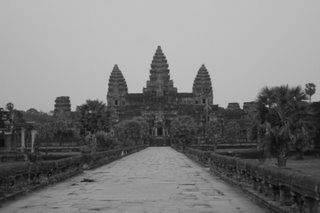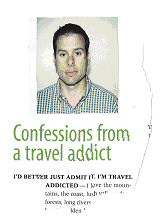Anchor What?

Or rather Angkor Wat, one of the Seven Wonders of the Modern World. Before the new millennium I would have given you a quizzical look at the mention of the name. More than thirty years of conflict with wars between the Khmer Rouge and the government and against the Vietnamese and the French curbed Cambodia’s tourist appeal. The country was perhaps better known for it’s “Killing Fields” as was first detailed in a non-fiction book and later dramatized in a Hollywood film of the same name. Today, Cambodia (mostly Siem Reap) is a new hot spot attracting over a million tourists annually and climbing.

Boarding the first available flight to Siem Reap from Ho Chi Minh City, my Fokker 77 departed at 3:40 in the afternoon. Given the late time of the departure, I was relegated to the day being one of pure transit and preparation for the coming visit to the temples. An hour and some rocky turbulence later, I was pleased my Fokker landed safely on the ground and hurriedly completed my visa application for entry into the country. The process was surprisingly smooth and I was out the door, luggage in hand, in less than 30 minutes.
Moving out of the terminal I presented my prepaid taxi voucher to a driver waiting nearby. The center of Siem Reap was about six kilometers from the international airport, the existence of which can be exclusively attributed to the Angkor temples. Just past the airport perimeter, I asked Thy (Pronounced “T”), my driver, if he would take a detour before going to my hotel. The sun would set in less than thirty minutes and I was hopeful that I could reach the main temple, Angkor Wat, at the end of daylight when it would be less crowded. For a steep $10, “half day charge’, Thy agreed and we drove past the hotel on the busy road to the main temple of attraction.
Pulling in front of the temple, there were a few hundred people returning from the main Angkor Wat temple to the road. I grabbed my camera bolting out of the car into the temple hoping I would be able to sneak my way past the guards, or at worst, resort to compensating them for staying past closing. Across the first causeway spanning a moat that was once 21 feet deep and today is more than forty yards wide, I caught my first glimpse of the main Angkor temple stuppas. Much like the Taj Mahal, a visitor’s first glimpse of the main attraction is through a door way, in this instance the perimeter wall around the temple.
The temple was clearing out as the sun set and I zigged and zagged my way around “security” ushering people on their way out of the temple courtyard. As light was swallowed by darkness, the shadows on the temple sandstone, comprising most of the exterior, revealed twenty shades of gray. Soon, I was alone in the temple courtyard snapping photos freely sans unknown random tourists in my viewfinder. “Beginner’s luck,” I thought to myself, as I was able to shoot the temples unobstructed, albeit in increasingly dim light.
Originally, Angkor Wat was known as just Angkor. “Angkor” literally translated means capital and “Wat” means temple. Commissioned by King Suryavarman II in the 12th century, the largest religious structure in the world took 38 years and more than 30,000 laborers to complete. It was not until the 16th century that the compound was put to use as a Buddhist shrine. Interestingly enough, there is a tremendous Hindu influence with carvings of Hindu gods Vishnu, Brahma and Shiva appearing throughout. For hundreds of years during the Spice Trade, Indians traveling to the Far East frequented the land known today as Cambodia. The resulting Buddhism practiced in Cambodia maintains heavy overtones of Hinduism.
 (View of Angkor Wat at sunset from Phnom Bakheng)
(View of Angkor Wat at sunset from Phnom Bakheng)When the last bit of light succumbed to nightfall, I found Thy, who returned me to a guesthouse of his choosing and subsequently a restaurant he recommended. Feeling he was not trying to scam me, I agreed to have him drive me to the temples with a guide friend of his the following day.
The following morning, Thy was prompt and his friend, Kham Rint, was ready to guide me through more than six centuries of Khmer history. Attempting to miss the tour bus crowds we started with west facing Angkor Wat as it was usually on the sunset agenda for large groups whereas Angkor Thom was east facing better for morning visits. As I had already been to Angkor Wat in the evening, visiting in the morning was a non-issue.
Khemrint, 27 years old, was not alive when Pol Pot, with the tacit (or perhaps explicit) permission of the King, was busy with the mass genocide of 1.7 million Khmers. From 1975-1979, Pol Pot's Khmer Rouge terrorized the countryside with brutal violence, and after he was pushed out of the country from international pressure, he continued his terror rampage for the next 20 years from his compound near the Cambodia/Thai border. Khermrint, who grew up outside of Siem Reap, recalls vividly scattering through the jungle behind his home as bullets whizzed by him hitting leaves within feet of him. His boyhood home, like many others in the rural communities, had a deep hole behind it for hiding during attacks from the Khmer Rouge. His father worked as an accountant for the government so he was in a persistent state of worry that his father would be singled out by the rebels for regularly occurring assassinations. Fortunately, his father was never targeted.
Today, Khemrint no longer lives in fear, but he does not believe Pol Pot is dead and he is not alone. Many Cambodians remain unconvinced that Pol Pot died in 1998 despite being shown pictures of his body. The air of Siem Reap is non-violent for the moment, thanks in large part to the large influx of foreign money to the province. Interest from abroad is so strong that Japan has taken a vested interest in Cambodia’s national monuments and pride.
In 2005, a Japanese company entered into a 30 year lease for the Cheung Ek Killing Fields at the absurdly low sum of fifteen thousand US dollars per year. And it is rumored, although I have been unable to confirm that Japan has also leased the Angkor Wat temples and collects a large percentage of the $20 per day tourist charge. By next year, a larger airport with new terminals and a longer runway will be completed permitting larger planes from international destinations to land. And who funded this large scale project you might ask? You might have guessed it, Japan.
 (One of 216 faces at Bayon)
(One of 216 faces at Bayon)There are more than three hundred temples in total throughout the Siem Reap region. Only thirteen are open to visitors. At the present and growing rate of mass tourism, the monuments are in need of a lot of maintenance and protection from further looters. Already the heads of most of the buddhas, gods and demons have been removed, some for private collections and others for museum displays in France and Phnom Penh (Cambodia's capital). Still, if you are heading to SE Asia, Siem Reap is a must see destination as the temples magically transport you 1,000 years back in time.
 ("Band of Monks")
("Band of Monks")


<< Home